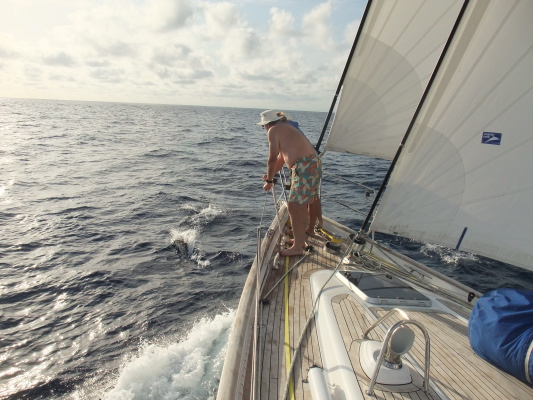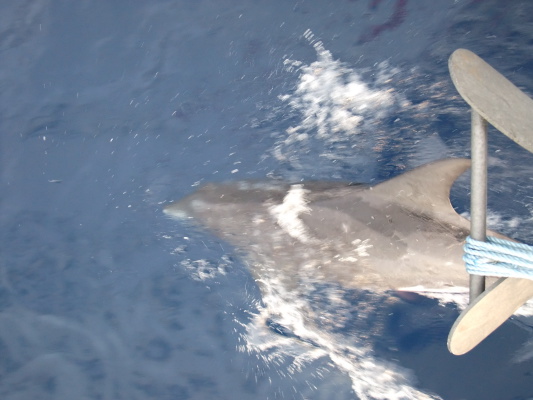Day 7 - Desert Island Discs & Marine Life

Sulana's Voyage
Alan and Sue Brook
Sat 27 Nov 2010 18:27
19:05.65 N 26:15.50 W
as at 17:00 on the 27th, which puts us 550 miles off the African coast and still some 2,000 miles from the finish, but better off than we were.
Stopping sailing South and concentrating on getting West, per our new plan, seems to be paying off, for now.
We had to gybe in the wee hours of this morning, all as predicted by our
weather GRIB files forecast, which is reassuring to know. That means they
ARE worth having!
GRIB files give you a map of the Atlantic Ocean with lots of little wind
arrows drawn all over it, so you can see a picture of what direction and
wind strength you are likely to get in any one place, at a particular time
in the future - For those who didn't know!
The big Pink, White & Blue spinnaker with the large White Gannet flying
across it, i.e. our very own 'Sula Bassana' has now finally come down.
(Look Sula up in a bird book, to see what a Gannet looks like!). Our
colourful spinnaker has been replaced by our cutter-rigged, twin headsail
rig, as the wind has finally come round to the South and forced us to harden
up, if we wish to keep on our Westerly course. Inspecting the running gear
when the spinnaker was down we found considerable wear to the guy
Later tonight we fully expect the wind to come further round (veer) to the
South South West and head us, so we have to tighten sheets and come onto the
wind in a bit more wind, perhaps 22 knots! So down below the crew are busy
stowing stores and tidying up in preparation for heeling over a lot more and
having to prevent gear and food flying around!
Our plan is to go a bit to the North before we get headed too much and then,
when we do, to tack back to the West as soon as we can. After that,
hopefully, we will be on starboard tack, reaching hard into St Lucia, in
fair winds at last!
We have now started our daily listening to our Podcast selection from Radio
4. 'Desert Island Discs' is forming the basis of a regular afternoon
session, preparatory to running our own version amongst each of the crew.
This is followed by an instalment of 'A History of The World with 100
objects from the British Museum', which Alan downloaded especially for the
enlivenment of his limited historical brain on this trip.
These two superb programmes are typical of what we think makes the BBC such
good value!
First on the celebrated Desert Island with Kirsty Young was young Tommy
Woodward, probably better known to most of you as Tom Jones. He was very
straightforward, funny and down-to-earth.
Now, however, we cannot stop James from doing his Welsh imitation of Tom
Jones's imitation of his father telling off young Tommy for taking his Mam's
position at the dreaded, daily evening task of scrubbing the coal dust off
his Da's back, after the parents had had a tiff!
When you next see him, get James to explain it to you!
It's easier to appreciate that way, but a good laugh to all on board Sulana,
nonetheless!
We have also now discovered why we aren't getting many fish to bite. This
morning James and Fi were on watch when they saw a small group (pod) of
Dolphins swimming towards Sulana. One of them swum right under our bow,
popped its head up and grinned at them, not once, but twice, to show off the
large Tuna it had in its mouth. Talk about rubbing it in!
From a later revisit of the same mammals we took their picture and thencontemplated the oracle (in the form of our onboard bible of such things -
the brilliant "Sealife",edited by Geoffrey Waller and published by the
Smithsonian).
The considered view now is that these were Pantropical Spotted Dolphins,
because they had a white tip to their noses! So Stenella Attenuata it is! We
have also seen several of their seemingly more common, close cousins, the
Atlantic Spotted Dolphins as well.
They are being over-flown by several small, solitary, black and white
seabirds, which are some kind of Storm Petrel, maybe the Band-Rumped, or
'Madeiran' type we saw earlier in our voyage, off the coast of Madeira. They
are, like so many seabirds, really difficult to identify, though.
We have also seen our first flying fish, skipping and scudding away, across
the wavetops to leeward, as we disturb them. Our first real proof we are
heading towards the tropics!
And that's it for now.on the Sulana Marine Life study course.

